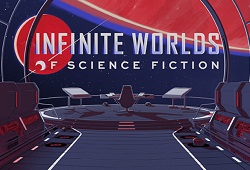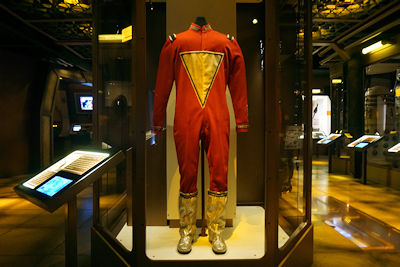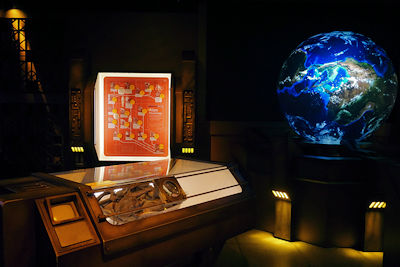
While our Solar System contains the planets Venus, Mars and Jupiter, the galaxy of science fiction has Tatooine, Gallifrey and Arrakis among its numerous and varied worlds. Although fictional, these planets offer exquisite environments and breathtaking landscapes just like the real-world planets that orbit the Sun, with the notable addition of alien beings that are both different and similar to those found on Earth.
The Infinite Worlds of Science Fiction exhibit at the Museum of Pop Culture in Seattle spotlights many of these fictional planets, inviting visitors to explore their natural wonders. The exhibit itself is designed as a “space ark” filled with artifacts collected by an unknown species that has been roaming the galaxies for eons before finding its way to Earth.
“This craft has been traveling the cosmos for hundreds, perhaps thousands, of years,” the entrance to Infinite Worlds of Science Fiction explains. “It has visited many other worlds, gathering strange and unusual objects. It has also visited future Earths and alternative Earths where history took a different course. We do not know who made this craft. It is fully automated, with no crew. Its mission, apparently, is to travel, observe and collect. Now it has arrived here to share its discoveries.”
The alien ark is filled with glass-enclosed display pods containing “artifacts” from different civilizations, with brief informational overviews about the planet and the types of species that populate them. These “artifacts,” meanwhile, are actual props, costumes and paraphernalia from such science fiction classics as Doctor Who, Battlestar Galactica and Star Wars.
The collection is impressive, with a Terminator skeleton, full-fledged Jawa, a Cyberman and Dalek from classic Doctor Who, and even the Ork uniform worn by Robin Williams in the 1970s television show Mork & Mindy all on display. A selection of hover boards from Back to the Future, proton packs used by the Ghostbusters, and the red dress worn by Number Six from Battlestar Galactica can also be seen among the 150 sci-fi artifacts.
Infinite Worlds of Science Fiction is more than just props and costumes, containing an interactive element as well. Although the craft is “fully automated,” visitors can sit in the cockpit and guide the ship to the fictional locales it has already visited – as well as explore new ones – while a second command post allows access to additional information about the various species and planets that make up the ever-growing galaxy of science fiction.
The exhibit likewise stresses, however, that each of these worlds were created by human beings and although fictional, they contain snippets of reality within them that can teach us about our own world – including race relations, environmental decay, and the dangers of scientific research run amuck, as well as the many wonders that await us in the future.
As technology advanced when it came to observing the stars, scientists began discovering exoplanets outside our known Solar System. Although their real-world terrains are still indistinguishable, the planets envisioned by sci-fi creators offer glimpses into the possibilities nonetheless, from the desert dunes of Arrakis and Tatooine to the snow-and-ice covered Hoth and the mountainous LV-426, proving that life can indeed imitate art – especially within the realms of science fiction.
The alternate Earth of The Terminator and distant Twelve Colonies of Kobol of Battlestar Galactica, meanwhile, warn of the potential dangers of artificial intelligence and robots more advanced than the humans who created them. The loveable Mork from Ork, on the hand, offers insights into the human psyche from an alien being who finds earthlings just as alien as we find him amusing, and portrayals of the year 2015 from Back to the Future Part II allows visitors to explore a future that was once expected but failed to materialize.
Infinite Worlds of Science Fiction also teaches us about heroes, from Ellen Ripley of the Alien franchise to Sarah Connor of The Terminator, the Doctor from Doctor Who to the Ghostbusters of New York City. More importantly, these characters demonstrate that anyone can be a hero – regardless of gender, race or creed – and that the “right stuff” resides in everyone rather than just a select few. They may have originated within someone’s imagination but they reflect the human spirit in each of us nonetheless.
The wonders of science fiction likewise mirror the wonders of our own world – sometimes for the better and sometimes for the worse. They allow us to envision the multitude of possibilities that exist for the future, and demonstrate that everyone has the ability to create a better world. Just as the Star Trek of the 1960s led to an influx of young scientists whose later technological achievements directly related to those found in the original series, additional futures still reside within the fictional narratives of the Infinite Worlds of Science Fiction that are waiting to become reality as well.
“With unlimited imagination, boldness and creativity, step aboard this enigmatic spacecraft and discover how science fiction allows us to break away from the confines of the tangible world,” the Museum of Pop Culture invites visitors to the exhibit. “Experience the power it has to transform, motivate and educate. And glimpse at the spectacular places born from intellect, wonder and unbound appreciation for the human species encountering change. What secrets will you unearth?”
The answer may be different for each of us but derives nonetheless from a shared galaxy of infinite worlds within the realms of science fiction – and fueled by the imagination of the human mind.
Anthony Letizia





